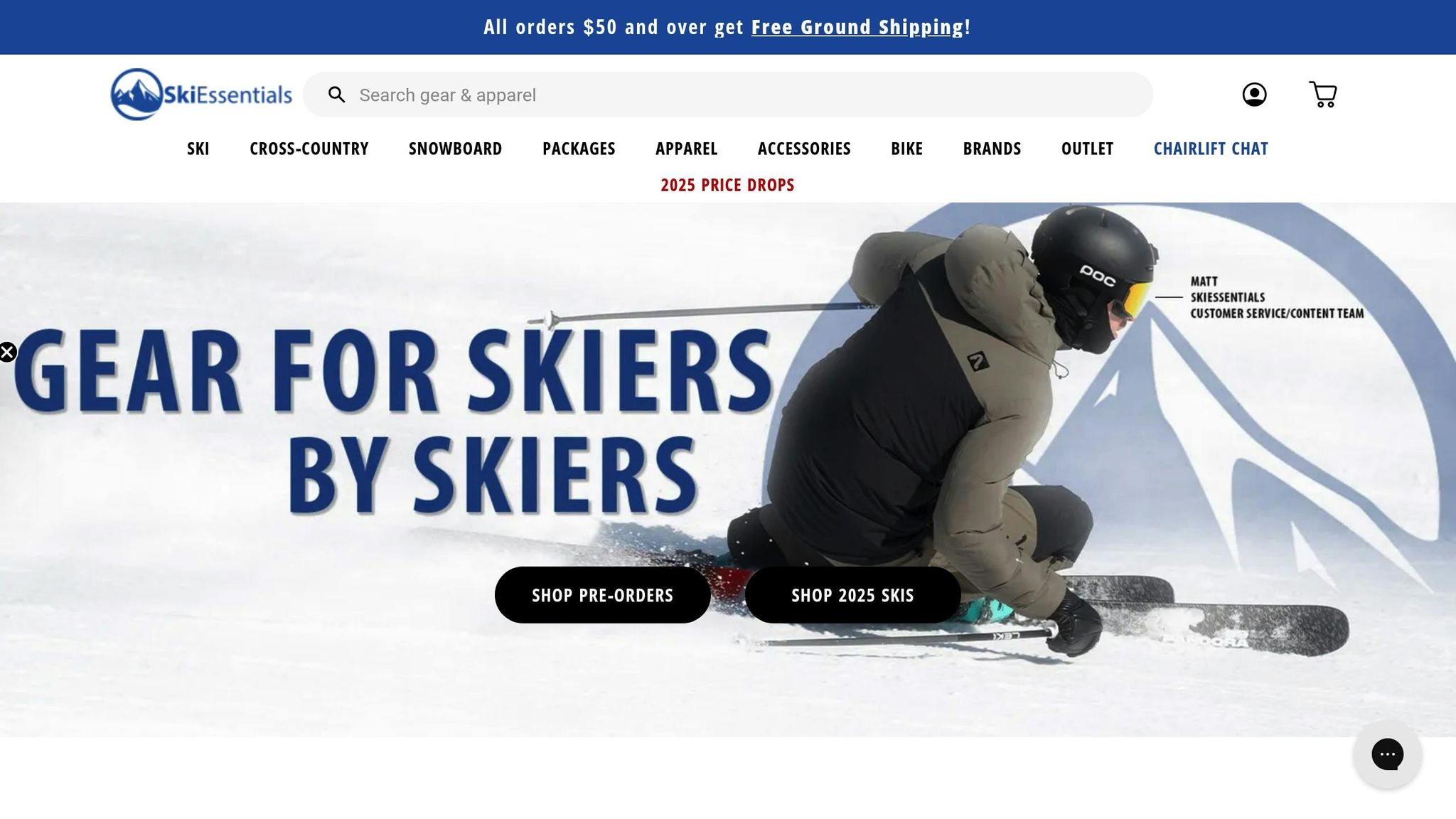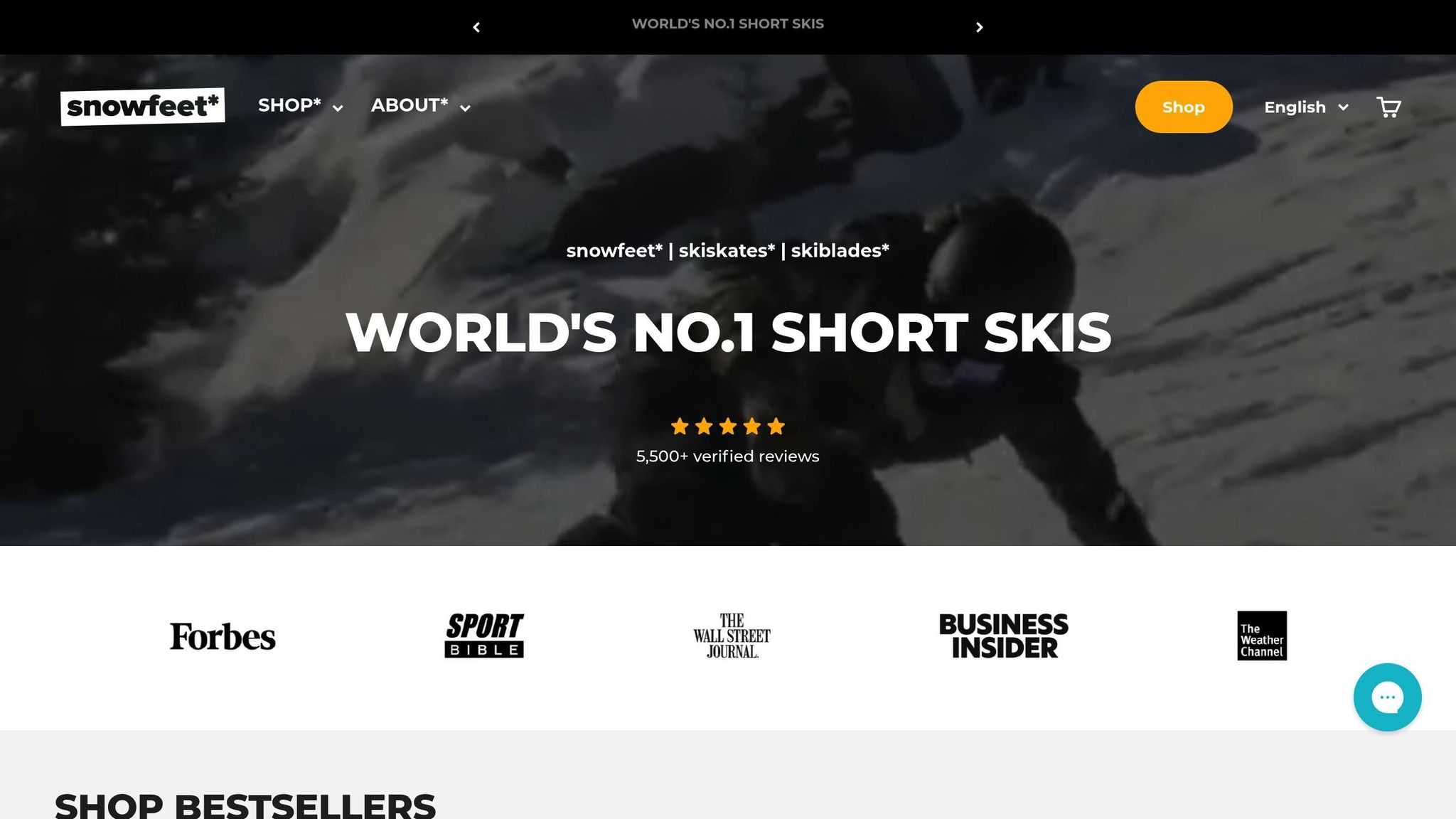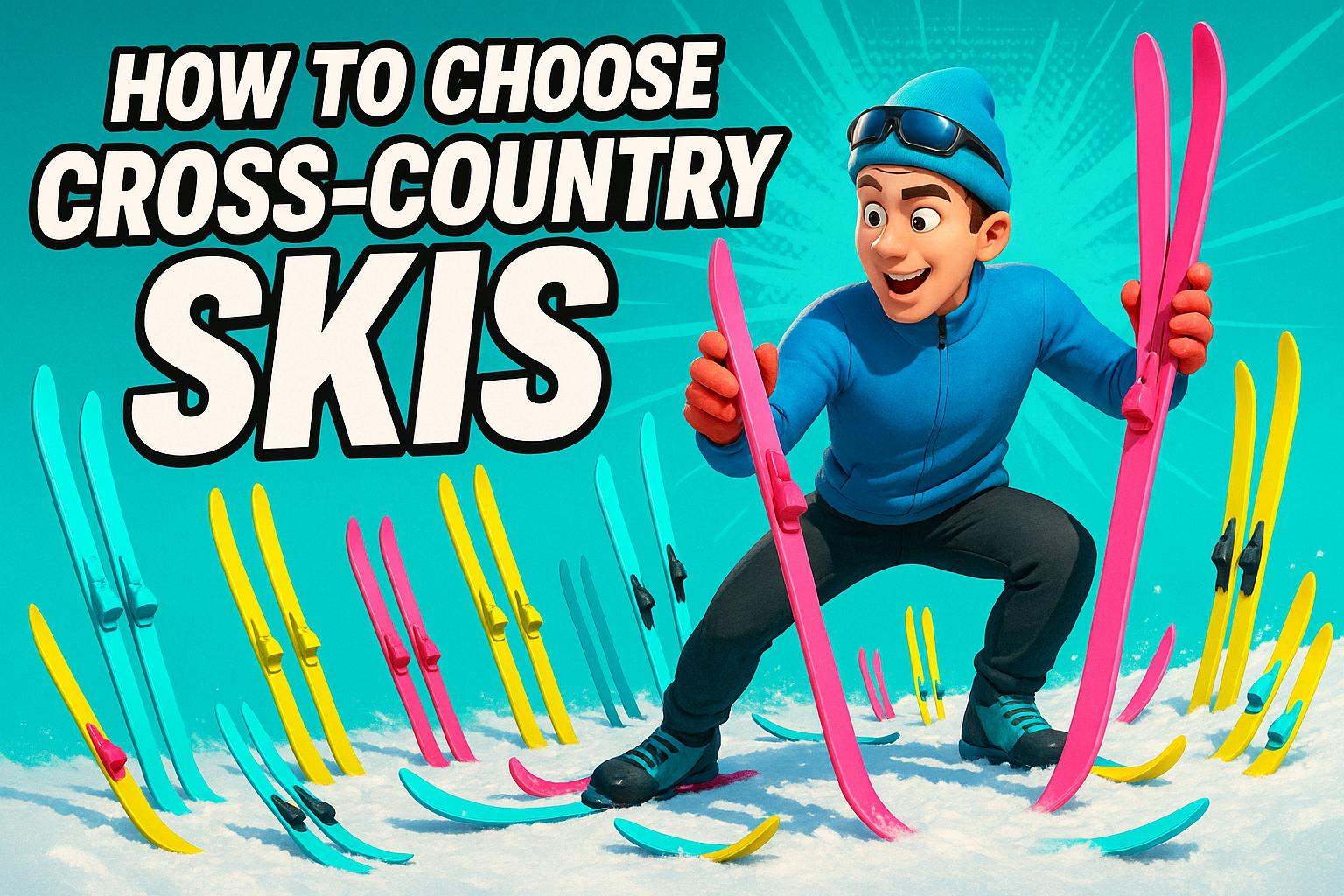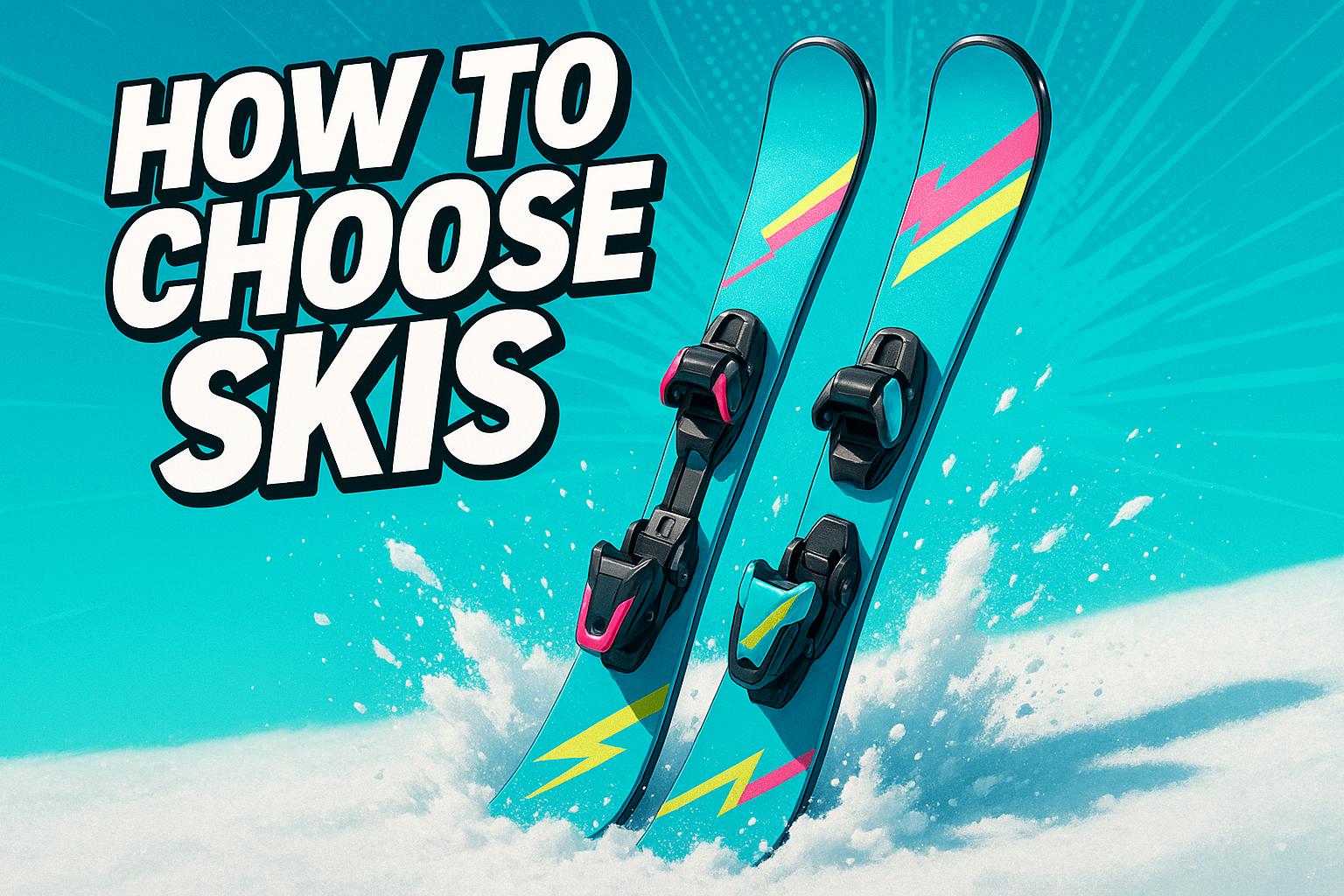バックカントリースキーは未踏の雪景色を探検するエキサイティングな方法ですが、安全で楽しい体験のためには適切なギア選びが重要です。始めるために知っておくべきことはこちらです:
- 初心者に最適な選択肢:Snowfeet* WALKSKIはコンパクトで軽量、手頃な価格のスキーセットアップです。長さわずか100cm、価格は$499で、扱いやすく通常の冬用やスノーボードブーツで使え、専用ギアの費用を節約できます。
- 伝統的なロングスキー:通常160cm以上で、フルセットアップで$2,200+かかります。多様な地形での安定性を提供しますが、重く持ち運びが難しく、専用ブーツが必要です。
- ビンディング:Snowfeet* のビンディングは調整可能で使いやすく、標準的なブーツに対応しています。高価なスキーブーツが必要な従来のセットアップとは異なります。
- クライミングスキン:登り坂でのグリップのためにスキーに取り付けます。Snowfeet* のスキンは短くて扱いやすく、コンパクトなWALKSKIに最適です。
簡単比較
| 特徴 | Snowfeet* WALKSKI | 伝統的なロングスキー |
|---|---|---|
| 長さ | 100 cm | 170+ cm |
| 体重 | 軽量 | 重い |
| ブーツの互換性 | 通常の冬用/スノーボードブーツ | 専用スキーブーツ |
| 価格 | $499 | $2,200+ |
| 操作性 | 狭い場所でも簡単に操作できる | 狭い地形では扱いが難しい |
| 携帯性 | バックパックに収納可能 | 専用キャリアが必要 |
バックカントリースキーが初めての方には、Snowfeet* WALKSKIは初心者に優しく、コストパフォーマンスの高いスタート方法です。軽量で携帯性があり、使いやすいため、最初の冒険をより身近で楽しいものにします。
SkiEssentials.comと一緒に初めてのアルパインツーリングスキーセットアップの選び方 - ブーツ、ビンディング、スキー

バックカントリースキーの選び方:Snowfeet* vs 伝統的なロングスキー

Snowfeet*はバックカントリースキー選びの常識を変え、伝統的なモデルの優位性に挑戦する特徴を提供します。彼らのWALKSKIが伝統的なロングスキーとどう比較されるか見てみましょう。
スキー選びの重要な要素
スキーを選ぶ際は、体重、操作性、地形への適合性、ブーツの互換性を考慮する必要があります。体重は特に重要で、長い距離をギアを背負って登るためです。Snowfeet* WALKSKIのような短いスキーは狭い場所で扱いやすく、伝統的なロングスキーは重くて機敏さに欠ける傾向があります。
地形も大きな考慮点です。RossignolやAtomicのようなブランドは、深いパウダーを含む多様な条件に対応するロングスキーを設計しています。一方で、コンパクトなSnowfeet* WALKSKIは整地された雪や狭いトレイル向けに作られています。携帯性も非常に重要で、軽くて持ち運びやすいギアはバックカントリーの冒険を左右します。そして学習曲線も忘れてはいけません。使いやすいギアは、斜面を楽しむ時間を増やし、立ち続ける方法を考える時間を減らします。
Snowfeet* WALKSKIの際立った特徴の一つは、伝統的な高価で専門的なスキーブーツが必要なセットアップとは異なり、標準的な冬用またはスノーボードブーツに対応していることです。
比較:Snowfeet* WALKSKI vs 伝統的なロングスキー
これら二つのセットアップを並べて比較してみましょう:
| 特徴 | Snowfeet* WALKSKI | 伝統的なロングスキー(Rossignol、Atomicなど) |
|---|---|---|
| 長さ | 100 cm (≈39 in) | 170+ cm (≈67+ in) |
| 体重 | 超軽量 | 重い |
| 操作性 | 狭い場所に最適 | 狭い地形では制限がある |
| 携帯性 | バックパックに収納可能 | 専用のキャリアが必要 |
| ブーツの互換性 | 冬用またはスノーボードブーツで使用可能 | 専用のスキーブーツが必要 |
| 習得の難易度 | 初心者に優しい | より難しい |
| 登り坂の効率 | 軽量のため優れている | 疲労を引き起こす可能性がある |
| 価格 | $490 | $2,200+ for a full setup |
伝統的な長いスキーは、通常160cm以上の長さで、多様な地形での安定性と滑らかな滑走を目的に設計されています。しかし、その大きさゆえに急な斜面や狭いトレイルでは扱いが難しくなります。それに対して、より短く軽量なSnowfeet* WALKSKIは、優れた操作性を提供し、登り坂でも少ない労力で済みます。価格差も顕著で、伝統的なスキーのフルセットはWALKSKIの4倍以上の費用がかかることが多いです。
なぜ Snowfeet* WALKSKI が初心者に最適なのか
バックカントリースキー初心者にとって、Snowfeet* WALKSKI の利点は見逃せません。従来のロングスキーはその大きさと複雑さで圧倒されがちですが、WALKSKI のコンパクトなデザインと扱いやすさは初心者にとってずっと親しみやすい選択肢です。
携帯性も大きな魅力です。バックパックに入れて汗をかかずに人里離れたトレイルへ行けます。さらに、標準の冬用靴やスノーボードブーツが使えるため、高価な専用靴にお金をかける必要がありません。これにより、複雑にせずに気軽にスロープを楽しめる敷居が下がります。
要するに、Snowfeet* WALKSKI は手頃でシンプル、そして楽しいバックカントリースキーの始め方を提供します。初心者が自信をつけて初めての雪上冒険を楽しむために設計されたセットアップです。
バックカントリー用バインディングの選び方
バインディングはブーツとスキーをつなぐ重要な部分で、適切なものを選ぶことがバックカントリーの冒険を成功させる鍵です。従来のバインディングは高価で専用のブーツ(400~800ドル)を必要とし、セットアップも複雑です。RossignolやAtomicなどのブランドは長年これらのシステムと伝統的なロングスキーを組み合わせてきました。
バインディングの種類:従来型とSnowfeet* のアプローチ
Snowfeet* は、通常の冬用靴やスノーボードブーツで使えるバインディングを提供し、専用の高価なブーツは不要にしました。すでに冬用靴やスノーボードブーツをお持ちなら、そのまま使えます。このアプローチにより、新しいギアの追加コストなしでバックカントリーの楽しみが広がります。
Snowfeet* には、さまざまなニーズと予算に合わせた3つのバインディングモデルがあります:
- Basic bindings:予算に優しいオプションですが、大きなスノーボードブーツには完全にフィットしない場合があります。
- Standard bindings:より頑丈に作られており、大きめのブーツにも快適に対応する追加のストラップが付いています。
- Pro X bindings:最高級の選択肢で、あらゆるブーツサイズに対応する最大の耐久性、快適さ、精密な調整機能を提供します。
ラインナップを紹介したところで、Snowfeet* バインディングが際立つ安全性と使いやすさの特徴を詳しく見ていきましょう。
安全性と調整機能
Snowfeet* は使いやすいバインディングシステムでシンプルかつ安全を保ちます。これらのバインディングはUSサイズ6~13(EU38~47)に調整可能で、ほとんどのユーザーにぴったりフィットします。ストラップの長さを調整するにはドライバーだけが必要です。調整後にストラップが長すぎる場合は、余分な部分を切ってすっきりとしたフィット感にできます。
最高の体験のために、Snowfeet* は防水性があり足首をサポートする靴の着用を推奨しています。バインディングには安定性を高めるカスタムの滑り止め表面も備わっており、セットアップが簡単です。この信頼性が高く調整可能なシステムにより、ギアの調整にかける時間を減らし、バックカントリーでのカービングをより楽しめます。
sbb-itb-17ade95
登坂スキンの選び方:フィット、素材、性能
登坂スキンとは何か、なぜ必要なのか?
登坂スキンは登りスキーの秘密兵器のようなものです。これらの便利なストリップはスキーの底に取り付けられ、急な登りで後ろに滑るのを防ぎます。下りの時は簡単に剥がして滑走を楽しめます。
Rossignol や Atomic のようなブランドの伝統的なロングスキーは全長スキンを使い、特に風の強い状況では扱いが面倒です。しかし、Snowfeet* WALKSKI はコンパクトな 100 cm デザインなので、ずっと短いスキンが必要です。これらは扱いやすく持ち運びも簡単で、洗練されたバックカントリーセットアップにぴったりです。
重要なポイントは?スキンは最高のパフォーマンスのために Snowfeet* WALKSKI の特定の寸法に合う必要があります。
Snowfeet* WALKSKI にぴったりのフィットを得る
まず WALKSKI の幅を測り、スキンが無駄なかさばりなく完全にカバーできるようにします。100 cm スキー用のスキンを探し、必要に応じて正確にトリミングしてください。調節可能な先端とテールのクリップは必須で、WALKSKI の独特な形状にスムーズに対応する必要があります。また、接着剤が冒険中に遭遇する温度に耐えられることを確認しましょう。
フィット感が決まったら、登坂スキンの素材を選びましょう。
素材の選択肢:ナイロン、モヘア、または混合
登坂スキンの素材は斜面での性能に大きく影響します。簡単にまとめると:
- ナイロンスキン:頑丈で優れたグリップ力を持ち、初心者に最適です。代わりに滑走はあまり滑らかではありません。
- モヘアスキン:滑らかで楽な滑走を求めるならモヘアがおすすめです。ただし、耐久性は低くグリップ力も劣ります。
- 混合ナイロン・モヘアスキン:これらはグリップと滑走のバランスが良く、特に Snowfeet* WALKSKI に最適です。
Snowfeet* WALKSKI はコンパクトで扱いやすいため、極端な耐久性を持つスキンは必要ありません。初心者は登坂時のトラクションと安心感のためにナイロンや混合スキンを選ぶと良いでしょう。スキンを良好な状態に保つために、常に乾燥かつ清潔に保管してください。
必携アクセサリーと実用的なヒント
必須のバックカントリーアクセサリー
WALKSKI セットアップを最大限に活用するには、調節可能で軽量なアルミニウム製スキーポールを用意しましょう。これらは登り坂でバランスを保つのに役立ちます。Rossignol や Atomic のようなブランドの伝統的なロングスキーは専用のポールが必要なことが多いですが、コンパクトな WALKSKI は標準的なポールで十分機能します。
次に、スキーツーリング用に設計された軽量バックパックに投資しましょう。Snowfeet* WALKSKIは従来のスキーよりずっと軽いため、小さくてスマートなパックを選べます。外部のスキーキャリーストラップや雪崩安全装備への素早いアクセス用コンパートメントなどの機能を探してください。
安全の話をすると、必須の雪崩装備を忘れずに:ビーコン、プローブ、シャベル。American Institute for Avalanche Research and Educationの元エグゼクティブディレクター、リチャード・ボスウェル氏が指摘するように:
"スキーヤーは雪崩トレーニングだけでなく、ギアの知識と故障時の修理方法もしっかり身につけるべきだ"。
スキーストラップ、応急処置キット、基本的な修理工具も持ち歩くのが賢明です。Snowfeet*システムはシンプルですが、準備は万全に。交換用ネジやマルチツールなどの必需品があれば、トラブル時に助かります。これらの小さな追加アイテムが装備を完成させ、バックカントリーでの安全と効率を確保します。
Snowfeet*のアクセサリーであなたの装備を充実させましょう
滑らかな滑走と簡単なメンテナンスには、Snowfeet*のワックスが必須です。WALKSKIのプラスチック製構造に特化して設計されており、塗りやすく、ベースに雪が付着するのを防ぎます。従来のスキーのように専門的なワックスが必要ないので、手間いらずです。
交換用ストラップも手元に置いておきたいですね。頻繁に使うと摩耗しますが、Snowfeet*は手頃で交換が簡単なパーツを提供しています。彼らの冬用ウェアもまた魅力的で、伝統的なスキーギアのかさばりを抑えつつ暖かさを保つ設計で、WALKSKIシステムのコンパクトで軽量な哲学にぴったり合います。
米国バックカントリースキーの実用的なヒント
軽量な装備が整ったら、バックカントリーでの体温管理が重要です。定番のアドバイスを守りましょう:
"大胆に行こう、寒く始めることは最高のツアーモットーだ、100%守ろう"。
ツアーの開始時は少し寒く感じるかもしれませんが、登り始めるとすぐに体が温まります。
雪の状況を確認するときは、ほとんどの米国の雪崩レポートがヤード・ポンド法を使っていることを覚えておきましょう。「18インチの新雪」や「3フィートのベース」といった用語に慣れて、地域の最新情報を把握してください。
外出前に自宅でトランジションの練習をしましょう。ガレージやドライブウェイでスキンを装着して、凍った駐車場で慌てないようにするのがおすすめです。また、ビーコンが正常に動作しているか自宅でテストするのも良いアイデアです。
トレイルでは、スキントラックを踏むよりも滑走してエネルギーを節約しましょう。急な区間ではヒールリフターを使ってふくらはぎの負担を減らし、登りをより快適にします。
出かける前にオフラインマップをダウンロードするのを忘れないでください。多くの米国のバックカントリー地域では携帯電話の電波が不安定なため、スマホに地図があると非常に助かります。スナックや水は手の届くところに置き、一日中エネルギーと水分を補給しましょう。
最後に、ゆっくりと進めて自信をつけましょう。Snowfeet* WALKSKIは従来の長いスキーよりもコントロールが良いですが、簡単な地形から始めるのが賢明です。経験を積むにつれて、徐々により難しいコースに挑戦できます。これらのヒントを活用すれば、2025年のSnowfeet*セットアップでバックカントリーのすべてを存分に楽しむ準備が整います。
2025年の最高のバックカントリースキーセットアップ
なぜSnowfeet*が正しい選択なのか
バックカントリースキーに挑戦し、財布に優しく性能も高いセットアップを求めるなら、Snowfeet* WALKSKIが最適です。価格はわずか499ドルで、通常の2,200ドルのセットアップと比べて大きな変化をもたらします。品質を犠牲にせずに1,700ドルもの節約が可能です。
WALKSKIが際立つ理由は?まず、冬用ブーツ、スキーブーツ、スノーボードブーツなど、さまざまなブーツに対応しています。軽量設計なので登りの負担が少なく、短い長さで狭いトレイルや木々の間を簡単に縫うように進めます[6,8]。
"私はこれが大好きです。とても楽しくて、スノーボードブーツを履くとまるでローラーブレードをしている気分になります。" – mbreuer
バインディングは自宅でドライバー一本で調整可能なので、特別な工具やショップに行く必要はありません。さらに、スノーボードスタイルのバインディングはサーフィンのような感覚を加え、トリックや鋭いターンがしやすくなります。コストを抑えるためにリリース機能はありませんが、安全でしっかりとしたフィット感を提供します。
バックカントリーセットアップの入手方法
Snowfeet*システムの始め方はとても簡単です。Snowfeet*のウェブサイトにアクセスして、完全なWALKSKIセットアップを499ドルで手に入れましょう。追加アイテムも忘れずに:100cmのクライミングスキン、Snowfeet*ワックス、交換用ストラップ。そしてもちろん、ビーコン、プローブ、ショベルといった雪崩安全装備は必須です。
バックカントリースキーが初めてなら、まずは簡単な地形で慣れてください。WALKSKIは初心者に優しい設計で、初めてスキーを履く人でも優れたコントロールを提供します。自宅でスキンの装着を練習し、携帯電話の電波が不安定なことが多いので、選んだバックカントリースポットのオフラインマップを必ずダウンロードしてください。
Snowfeet*システムの最もクールな点の一つは、その多用途性です。パウダー、圧雪トレイル、さらには整備された斜面でも、WALKSKIはあなたをサポートします。従来の長いスキーとは違い、理想的なコンディションを待つ必要はなく、ほぼどこへでも持っていけます。
手頃な価格、性能、使いやすさの絶妙なバランスを持つSnowfeet* WALKSKIは、2025年のバックカントリーアドベンチャーをレベルアップさせる完璧な選択です。
よくある質問
なぜSnowfeet* WALKSKIは、従来の長いスキーと比べて初心者にとって優れているのでしょうか?
Snowfeet* WALKSKIは、バックカントリースキーを始めたばかりの人にとって素晴らしい選択肢です。従来の長いスキーとは異なり、軽量でコンパクト、持ち運びが簡単なのが初心者にとって大きなメリットです。短い長さのおかげで扱いやすく、さまざまな地形に挑戦する際のコントロールと自信が向上します。
さらに良いのは、長いスキーよりも簡単に扱えることです。習得のハードルがずっと低いため、スキーを楽しむ時間が増え、慣れるのに苦労する時間が減ります。しかも予算に優しく、費用をかけずにバックカントリースキーを試したい人に最適です。もっと気軽に雪を楽しみたいなら、Snowfeet* WALKSKIは完璧なスタートポイントです。
Snowfeet* WALKSKIに適したクライミングスキンの種類は?また、最適なフィット感を得るにはどうすればいいですか?
Snowfeet WALKSKI*用のクライミングスキンを選ぶ際は、軽量で粘着性があり、ナイロンまたはモヘア製のものを選びましょう。各素材には特徴があります:ナイロンスキンは丈夫でしっかりグリップし、初心者やカジュアルスキーヤーに最適です。一方、モヘアスキンは滑りが良く、長距離トレッキングで効率を求める熟練者に人気です。
Snowfeet* WALKSKIはコンパクト(44〜120cmの間)なので、その短い長さに合わせてトリミングできるスキンが必要です。ぴったりフィットすることが、スムーズな登り移動とSnowfeetの携帯性・軽量設計を最大限に活かす鍵です。小型スキー用に特化したスキンを選ぶことで、バックカントリーの冒険がずっと楽しくなります。
Snowfeet* WALKSKIで最適なバックカントリースキー体験をするための必須アクセサリーは何ですか?
Snowfeet* WALKSKIでのバックカントリーアドベンチャーを最大限に楽しむために、いくつかのアクセサリーが大きな違いを生みます。クライミングスキンは登りでの移動を劇的に変え、雪の斜面を自信を持って登るためのグリップを提供します。良質なゴーグルは風や雪、まぶしさから目を守り、どんな天候でも視界をクリアに保ちます。そして、忘れてはいけないのが軽量で調節可能なポールです。特に地形が難しい時にバランスと安定性を保つのに最適です。
Snowfeet* WALKSKIの素晴らしい点は、そのコンパクトで携帯しやすいデザインで、これらのアクセサリーと見事にマッチします。従来のかさばるスキーとは異なり、このギアは面倒なく、より安全でスムーズ、そして便利なバックカントリー体験を提供します。

































コメントを残す
このサイトはhCaptchaによって保護されており、hCaptchaプライバシーポリシーおよび利用規約が適用されます。